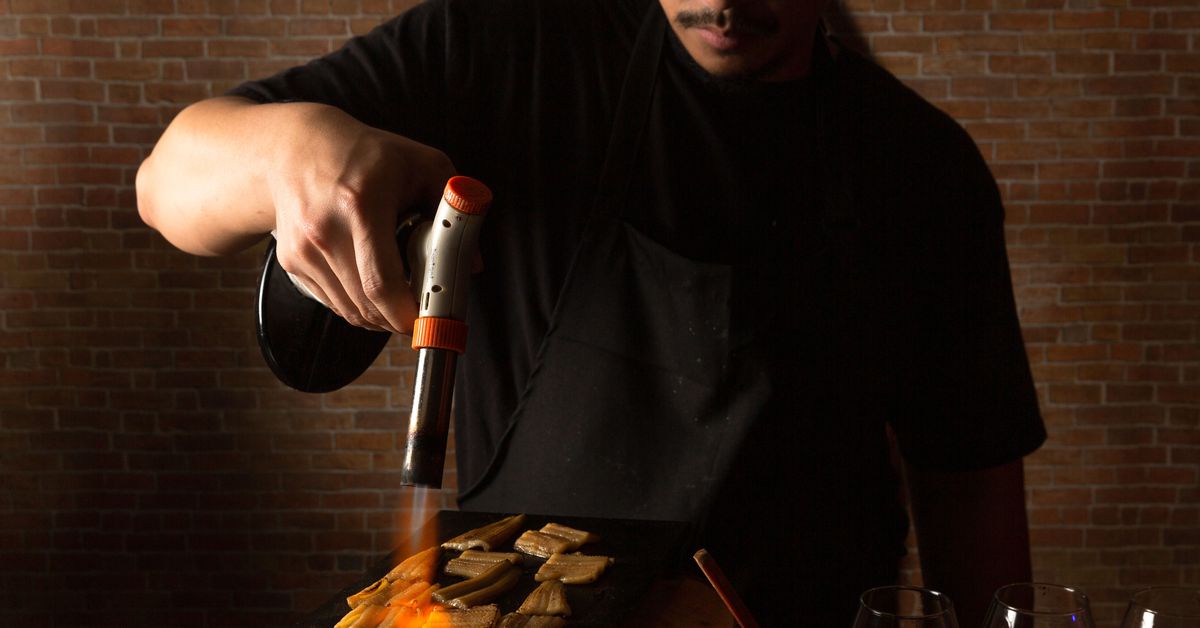
The going rate for a top-tier New York sushi meal is $400 before sake. It’s an absurd reality, fueled by supply chain issues, labor costs, and let’s be honest, plain old-fashioned greed. But here’s the saving grace: While New York’s best sushi will always trend in an expensive direction, you don’t have to spend an iPad’s worth of funds on an omakase date to have an incredible meal.
Once upon a time, Masa was the big-deal operator, and Michelin continues to navigate under the delusion that the Deutsche Bank Center restaurant, where dinner for two will top $2,000, is the country’s best sushi spot. But in the nearly two decades since that aristocratic venue opened, scores more high-end sushi venues have opened, some of them run by capable Masa alums, others having arrived from Japan and elsewhere. The 2011 documentary Jiro Dreams of Sushi, in turn, energized and educated a customer base that wanted to appreciate sushi — without dropping an entire paycheck on dinner. So what follows is an account of some of our favorite sushi meals at multiple price levels.
Wildcard/creative: Mari
Ryan: Tired of eating bluefin tuna three or more ways at every other omakase parlor? Mari is the place for you. Chef Sungchul Shim (Kochi) only serves more sustainable bigeye, and often offers just a single piece — as part of spicy tuna roll topped with crispy potato crisps. There’s surely not a single other New York omakase spot tearing up the traditional sushi envelope like Mari, which finds its niche with a cross between Japanese temaki and Korean kimbap. Imagine: Scallops with dressed with makgeolli vinaigrette, mackerel with black vinegar jelly, and soy-braised galbi wraps. In the style of kimbap, Shim eschews traditional sushi vinegar, seasoning his rice instead with aromatic sesame oil and daikon. And every meal ends with a heart bowl of chicken guk-su noodle soup. Cost: $135.
Best takeout/delivery: Osakana, Nami Nori
Robert: There is a slew of sushi delivery places around town, many of them no better than ghost kitchens. Let’s face it, in the time it takes to deliver your sushi, the fish often becomes tired, the rice finger loses its stickiness and falls apart, and any nori that may be involved becomes damp and gummy. That’s why if you want to carry out sushi you’d better eat it right away, even if it entails standing on the sidewalk. The best sushi takeout I’ve found is hidden on a quiet block of St. Marks (yes, the middle one): At Osakana, a satellite of a famous Brooklyn sushi bar, customers pick up their sushi in what looks like a science lab, and no, they can’t sit down since it’s to-go only. The sushi is of the mildly innovative sort, with dabs of this and sprinkles of that and the fish is some of the freshest you’ve ever tasted, with assortments priced from $25 to $60.
Ryan: Robert! I have a solution for your gummy seaweed. The supply chain masters at Nami Nori have perfected the art of fancy delivery hand rolls. I know, I know. You can literally watch the nori on your caviar temaki go limp at an omakase spot if you stop to take a few iPhone pics, so how could such an indulgence possibly survive a bike messenger? The chefs cover the nori with a biodegradable plastic wrap that you slip off without disturbing the fillings; you’ll feel like a magician pulling the linens off of a set table. Result: Perfectly crisp seaweed underneath spicy crab, subtly funky XO scallop with tobiko roe, and yes, even creamy Santa Barbara uni.
Non-blowout omakase: Shuko, Icca, Moko, Sushi Lab
:no_upscale()/cdn.vox-cdn.com/uploads/chorus_asset/file/3369722/SHUKO_lead.0.jpg)
Ryan: Anything under $400 after tax and tip — while still objectively exorbitant — counts as non-blowout sushi in New York. Looking through that somewhat distorted lens, I’d recommend Shuko for those nights when you want to feel like a mere Hamptons millionaire, rather than a neo-industrial plutocrat. The $270 tasting might include soft toro tartare with osetra caviar, flights of good nigiri, and best of all, a mound of torched toro sinew, topped with fiery Thai chiles and oozing maritime fats. For a few dollars less, I found that the $210 bar omakase at Icca offers some quiet moments of pure bliss. Chef Noboru Komiyama used a torch to release the subtle oils of a blackthroat seaperch (imagine toro, but more restrained) and he dabbed just the right amount of roe on hairy crab nigiri, giving the crustacean enough sweet funk to linger on the palate for 10 minutes.
Robert: The East Village remains the sushi epicenter of the city, and it has readily embraced the modern omakase approach, with new places like Moko — a bright, semisubterranean sushi bar that throbs near the corner of St. Marks and Second Avenue — popping up on a daily basis. These ritualized, one-piece-at-a-time meals are often about half the price of what they are in the West Village. Moko’s rings in at $65 for 15 pieces, which must be accounted a bargain these days. But I prefer Sushi Lab, a serene spot that preserves a welcome atmosphere and the traditional reverence for raw fish as it delivers your eight pieces one at a time, plus a hand roll and farewell dessert, for $65. Highlights on a recent visit were sablefish with truffle miso and a sprinkling of chives, and sea bream with rose petals. Another branch occupies a nifty rooftop near Times Square.
Best vibes: Sushi on Me
Ryan: Sushi on Me is perhaps the only omakase restaurant that doubles as a reliable place to pregame. You spend an hour drinking, drinking, and drinking. You also eat. The staffers pour you bottomless sake while chef Atip “Palm” Tangjantuk presides over the cash-only ceremony like a frat pledge master. “Like the sign outside says, enjoy your fucking sushi,” he shouts. He hands out 12 pieces of sushi, one at a time, normally a practice for venues where folks don’t speak above a whisper. How good is this sushi? Never mind that; just keep downing sake while toasting with strangers and get ready to go out afterward.
Best Value: Blue Ribbon, Ginza Onodera
:no_upscale()/cdn.vox-cdn.com/uploads/chorus_asset/file/23903955/P1080728.JPG)
Robert: The Blue Ribbon empire, which started out peddling sushi late at night to chefs in the wee hours, isn’t the first place you’d expect to find a bargain. But somehow the new Blue Ribbon at Rockefeller Center has achieved that rare distinction where sushi is concerned. While carryout bowls of poke and the like are dispensed from a separate counter, there is an actual sushi bar where you can sit and enjoy six pieces and a roll for the astonishing price of $24. The selection doesn’t include more obscure forms of finfish and shellfish, however, but the most common types of sushi in scintillatingly fresh form, restricted to species like salmon, shrimp, and yellowtail. As with a rock band, sometimes you just want the greatest hits.
Ryan: There’s something ironic about how Ginza Onodera, one of the country’s most expensive sushi spots, affords a striking view of the New York Public Library, an institution dedicated to educating the public for free. But here’s a little deal: Those who book a seat for lunch will pay just $130 to $180, service included, versus $450 at dinner. On a recent Saturday, as a gentleman from out of town told me about his local culinary exploits (Masa) and his younger wife, chef Takuya Kubo sent out 12 fantastic pieces of Edomae sushi over 90 minutes. He gently torched Japanese barracuda, adding a bit of smoke to the luscious oils. He grated a touch of lime over akami to freshen up the lean bluefin. And he served this all over generous (sometimes too generous) mounds of sharply vinegared rice. If you’re looking for a standard luxe omakase, with mild, accessible flavors, this is your spot.
Hidden gem: Gosuke
:no_upscale()/cdn.vox-cdn.com/uploads/chorus_asset/file/24185258/SushiGosuke.jpg)
Robert: Years ago, some of the city’s best Japanese restaurants were found in Japanese hotels, offering a rare glimpse of how a restaurant might look and taste in Tokyo. The Henn na Hotel — a newcomer to Herald Square’s thriving hospitality scene — provides just such a glimpse. The focus of the lobby is a giant animatronic T. rex in a glass cage, but directly to the left of the sign-in desk is a curtained doorway that leads to a semisecret restaurant specializing in sushi and tempura. The sushi at Gosuke is great, and a bargain, with sushi assortments falling in the under-$50 range for seven or eight pieces of nigiri plus a hand roll, with an introductory miso soup — and no shame if you go the roll route instead, with lots of choices, The chirashi is an even better deal. A great casual spot filled with Japanese tourists.
Blowout omakase: Noz 17
Ryan: In Noz 17’s sedate, seven-seat dining room — just about the size of a rich person’s walk-in closet in Manhattan — chef Junichi Matsuzaki prepares a meal of 25 courses. The omakase is flat-out spectacular. Rather than following a linear progression of small plates to sushi and then dessert, the chefs seems to randomly switch among nigiri, otsumami snacks, small bites of sashimi, soups, and back to nigiri. Will you hear fellow diners talk about crypto? Sure, but after bites of shiitake mushroom sushi textured like pudding, dry-aged sea urchin as thick and creamy as brie, and baby sea bream that bounces like firm Jell-O, it’s hard to pay attention to anything but the food.
Should you dine at Masa?
Ryan: You should not. But you’d be forgiven for thinking it’s a vital stop for raw fish connoisseurs. Masa is the only U.S. sushi spot that holds three Michelin stars — even though dinner costs over $1,000 per person before a single drop of sake. Did I enjoy my single meal there in 2014? Tremendously, especially because it let me watch rich people act like rich people in a place where iPhone pics are banned. And it pains me to say the white truffle ice cream is outstanding. But could I discern why Masa’s nigiri was even an iota more technical or complex than at scores of other sushi spots — and that serve a more diverse array of masterfully aged and sliced fish? Not one bit.










































































Be the first to comment